Gender Gap in Sports Pay: An Introduction
As Stephen Curry steps onto the court this season for the Golden State Warriors, he’ll be the highest-paid NBA player for the fifth year in a row, pulling in $45,780,966, or more than $550,000 per regular-season game. It’s a distinction he’s earned thanks to two MVP awards, three championships, and a whole lot of sunken three-point shots.
Over in the WNBA, there are seven players making the max salary. These are legends of the game like Sue Bird and Diana Taurasi, each of whom have won five Olympic gold medals, and scoring powerhouses like Brittney Griner, Elena Delle Donne, and Liz Cambage. They each earn $221,450 per season, or about $6,900 per regular season game.
You don’t need a calculator to understand how wide that gulf is. But if you did get one out, you’d learn that the WNBA players would need to ask for a 20573.27% raise to match Curry. In this HowToBet article, we set out to answer the question: why is there a gender pay gap in sports, and what needs to happen to bridge the gap.
These are the superstar players of their respective leagues, but the picture for the typical professional basketball athlete isn’t much different. This season’s minimum salary in the NBA is $925,258 for a rookie, and it only goes up from there. NBA players average in the neighborhood of $10 million a year, while in the WNBA, it’s $120,648.
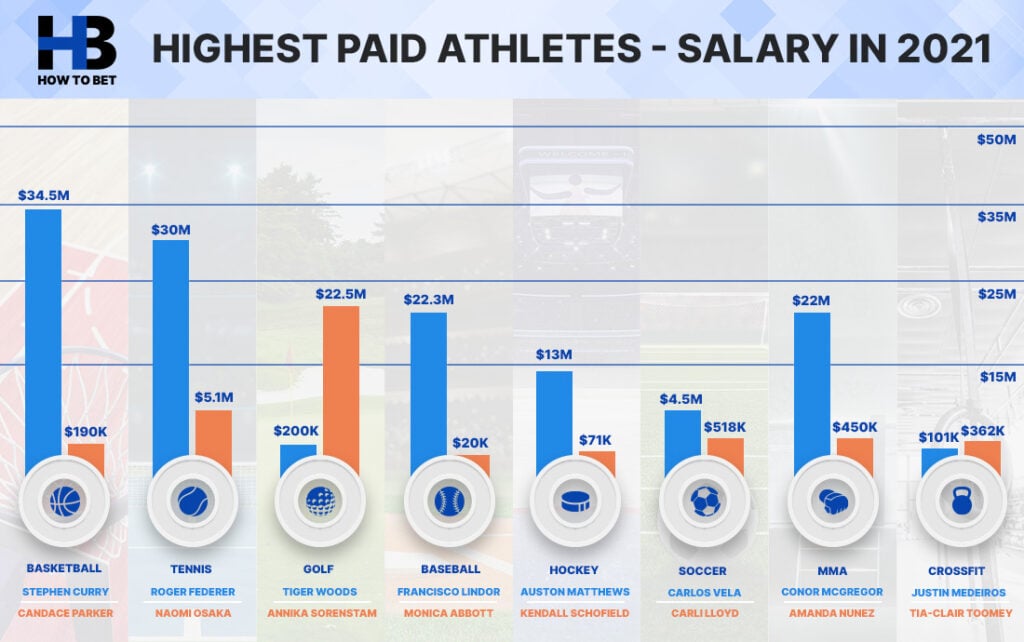
*Disclaimer: Woods has been sidelined since suffering serious leg and foot injuries in a car wreck in February 2021, explaining that he only made $200k in 2021.
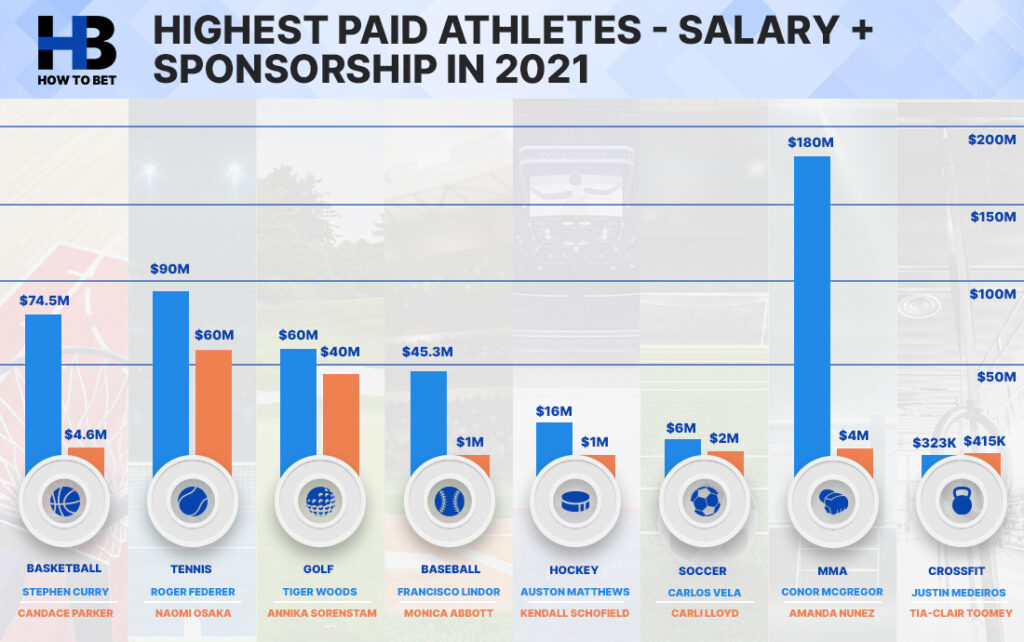
Tennis Leads the Way
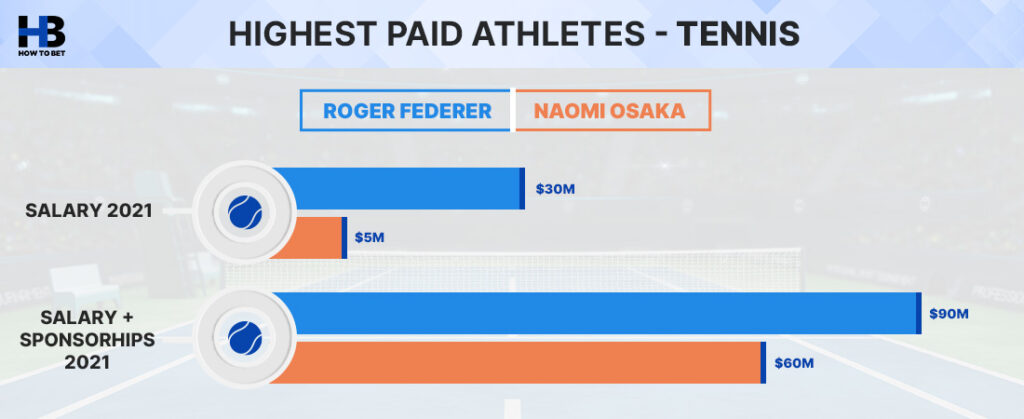
The older you are, the less likely these figures are to surprise you. That’s because the idea of paying women to play sports is much newer than the idea that men should be compensated for their athletic prowess. Consider that the NBA began in 1946, while the WNBA began in 1996, giving men a 50-year head start.
It wasn’t until the 1970s when the concept that women could be capable professional athletes really started to gain momentum. The decade saw point guard Ann Meyers sign a $50,000 contract with the Indiana Pacers, jockey Robyn Smith wins a stakes race, and racecar driver Janet Guthrie qualify and compete in both the Indianapolis 500 and Daytona 500.
Perhaps most notably for the future of professional women athletes, Billie Jean King and eight other tennis players, known as the Original 9, jeopardized their spots in the established tennis league and signed symbolic $1 contracts to play in a new women’s event.
They were motivated to risk their careers due to the expanding pay disparity between men and women. As tennis grew in popularity, the gender pay gap began to widen. It all came to a head in 1970, when the Pacific Southwest Open announced that the top man would win $12,500, while the women’s champion would earn just $1,500.
The players knew something had to be done to stop the marginalization. The gamble of the Original 9 paid off, as the rebellion turned into a full circuit of tournaments at which to play. When the immensely popular King threatened to boycott the U.S. Open in 1973 because of its pay disparity, the tournament became the first of the majors to award equal prize money to both the male and female winners.
Today, the only two women to crack the 2021 Forbes list of the top 100 highest-paid athletes in the world are tennis players (Naomi Osaka and Serena Williams). The four Grand Slam tournaments give equitable prize money, and tennis has one of the smaller gaps in pay between men and women — no doubt because of the work done decades ago to level the playing field.
| Rank | Name | Sport | Total Earnings | On The Field Earnings | Off The Field Earnings |
| 12. | Naomi Osaka | Tennis | $60M | $5M | $55M |
| 28. | Serena Williams | Tennis | $41.5M | $1.5M | $40M |
“Everyone thinks women should be thrilled when we get crumbs,” King said in 2016, “and I want women to have the cake, the icing, and the cherry on top, too.”
Billie Jean King
Softball Salaries Aren’t a Hit
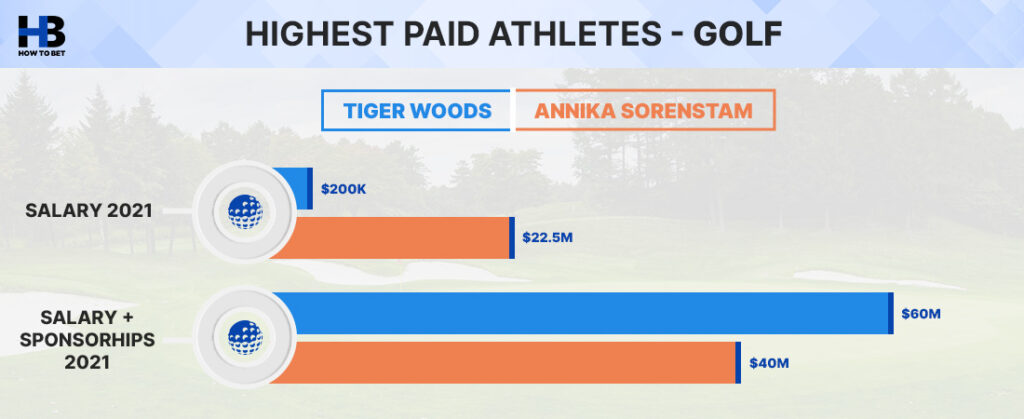
While there’s still a disparity in how much the men and women of tennis are paid — there’s a pay gap of about 34% — it’s less stark than the differences in most other sports.
Take golf, for example, wherein all the majors played by both men and women — the British Open, the U.S. Open, and the PGA Championship — the men’s first-place prize is more than $1 million above the women’s.
At the 2021 U.S. Open, Jon Rahm of Spain took home $2.25 million for winning his first major career championship, while Yuka Saso of the Philippines, also in her first major win, earned $1 million.
In many other sports, it’s difficult to pinpoint exactly what the pay gap is, given that the salaries of women are often not publicly disclosed. Still, we can make some inferences, even if we don’t know the individual figures.
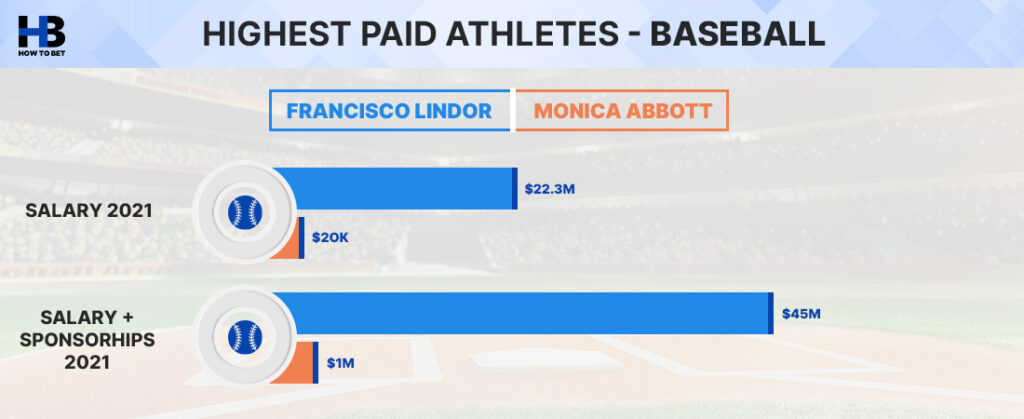
National Pro Fastpitch (NPF) — which announced in August 2021 that it was suspending league operations indefinitely — had a team salary cap of $175,000 before the 2020 and 2021 seasons were canceled. Given a full 28-player roster, that left an average of $6,250 for each player per season.
Scrap Yard Dawgs pitcher Monica Abbott made history in 2016 when she signed a six-year deal for $1 million — with a base salary of $20K per year and the rest made up in bonuses.
In contrast, Los Angeles Dodgers pitcher Trevor Bauer is currently the highest-paid player in Major League Baseball (MLB) after inking a three-year contract for $102 million.
MLB players average more than $4 million per season and make a minimum of $570,500, compared with the NPF’s minimum of $3,000.
A new sports organization, Athletes Unlimited (AU), debuted a softball league in 2020 with a focus on building the profile of players instead of teams. (Players switch teams throughout the season.) In its inaugural year, athletes received a minimum compensation of $10,000 for the six-week season, and AU paid out $1 million in salary across 57 players, along with a bonus pool of $300,000. The better a player performed during the season, the more she could earn in bonus money.
Veteran pitcher Cat Osterman, the highest-paid player in 2020, earned a little over $35,000 in base salary plus bonuses.
It’s still a far cry from the millions for a male pitcher of her caliber, but if the AU model proves successful, it could be a viable way for female athletes to make money moving forward.
The organization also has leagues for volleyball and lacrosse, with plans to venture into basketball in 2022.
From Field to Rink, the Story’s the Same
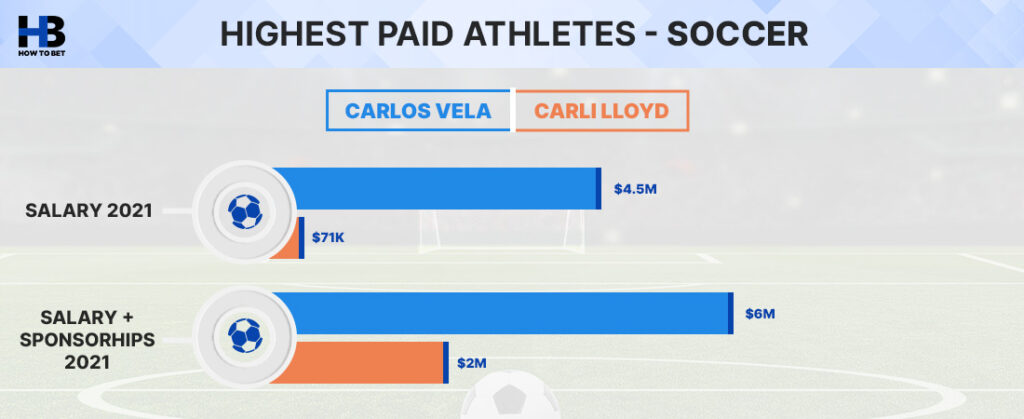
In the National Women’s Soccer League (NWSL), the salaries have been inching upward, although they lag well behind Major League Soccer (MLS).
For the 2021 season, women’s players’ salaries ranged from $22,000 to $52,500. The minimum and maximum salaries have increased every year since the league’s inception in 2013, when players were only guaranteed $6,000 and could make no more than $30,000.
In the MLS, no players make less than $63,547 (this is the baseline for the reserve roster), and the maximum salary is $612,500. The average player earns $398,725.
Earlier this year, the National Women’s Soccer League Players Association (NWSLPA) launched a campaign called #NoMoreSideHustles to bring awareness to salaries that are below a livable wage. Many players have to work a second or third job to make ends meet, on top of a demanding practice and travel schedule. The NWSLPA estimates that three-quarters of players are making $31,000 or less.
NWSLPA executive director Meghann Burke told CNBC Make It that when she played in the league, she donated plasma in order to get money to buy groceries, in addition to scrubbing toilets and delivering pizzas.
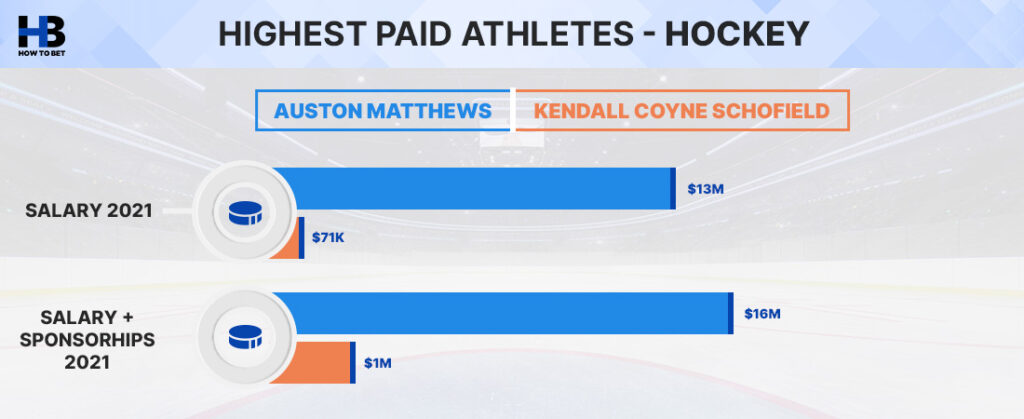
There’s an even wider pay disparity in ice hockey. In the National Hockey League (NHL), the minimum salary for the 2021-22 season is $750,000, with the average player earning more than $2 million, given salary and signing bonuses. Meanwhile, the National Women’s Hockey League (NWHL) has doubled its salary cap for the 2021-22 season, granting each team $300,000 total to spend — or, in other words, an entire 20-player team’s salary is less than half of what one men’s player would be guaranteed to make. Salaries for each NWHL player range between an estimated $10,000 and $35,000.
“This is something we can afford to do,” Boston Pride chairman Miles Arnone told The Associated Press of raising the salary cap. “It’s substantial, yet it doesn’t mark the end. It marks the beginning of a process we expect to go on over the next number of years.”
Miles Arnone
The Fight for Fair Pay
The struggle for equal pay for equal play is perhaps best exemplified by the U.S. women’s soccer team. In 2019, 28 players from the team sued U.S. Soccer over pay equity and working conditions — such as medical treatment, coaching, playing surfaces, marketing, and travel to games.
If anyone was poised to make the argument that women deserve fair pay, it was a team that’s long dominated on the international stage. They have inarguably been better than the men’s team in all measures of success, and yet after winning the World Cup in 2015, they received a bonus of $1.725 million from the United States Soccer Federation. That might seem like a gift, until you compare it with the bonus the men’s team got the year before, when they didn’t even manage to make it out of the Round of 16. For that, they earned an extra $5.375 million.
“Men are so often paid and compensated on the potential that they show, not necessarily what they’ve done,” said national women’s team member Megan Rapinoe in 2020. “And women are so often paid on what they’ve actually done — which normally I would say, we outperform what our contract was.”
To defend the pay gap, most people use the argument that men’s teams bring in more revenue and should be compensated accordingly. But from 2016 to 2018, the women’s soccer team brought in $50.8 million in revenue, while the men’s team brought in $49.9 million. And in 2019, Nike CEO Mark Parker said this on an earnings call: “The USA women’s home jersey is now the No. 1 soccer jersey, men’s or women’s, ever sold on Nike.com in one season.”
The idea that women’s sports simply can’t compare with men’s, that its players will never be as popular, has been disproven by this talented team.
U.S. Soccer announced in September 2021 that they would structure the men’s and women’s contracts in an identical fashion, but many players remain skeptical that it’s truly a good-faith effort to overcome the institutionalized gender discrimination they claim has been pervasive for so long.
And the next time they play at the World Cup, in a quest to defend their back-to-back victories, they’ll be competing for a much smaller amount than the men, whose prize purse in 2022 will be $440 million vs. the $60 million up for grabs during the women’s tournament in 2023.
The Future of the Gender Pay Gap in Sports

Will pay for women athletes ever catch up? Using tennis as a case study, we see that the gap can narrow — although 50 years after Billie Jean King and her peers took a brave stand, the playing field remains at least somewhat tilted.
Many of the women’s sports leagues are still young, and as they become more established, their stars will have more bargaining power. It’s also worth noting that newer niche sports like CrossFit have more gender parity baked into their DNA. The CrossFit Games offers an identical prize purse for male and female competitors, as it has from the beginning.
Real parity, especially among the legacy sports, will require a cultural shift in which management and fans view men’s and women’s sports as equally valuable. Perhaps surprisingly, this extends to the athletes themselves.
British tennis player Andy Murray — who’s long advocated for equal prize purses in tennis — has discovered in conversations with his peers that not all pro male tennis players want to see women compensated equally.
In a situation where the first-round loser’s check for men increased from, say, $8,000 to $10,000, and the women’s increased from $6,000 to $10,000, some men were against this — despite the fact that it meant a bump in pay for them, too.
“I spoke to some of the male players about that who were unhappy because the prize money was equal,” he said in an interview with CNN. “And I said, ‘Well, would you rather there was no increase at all?’ You know, they said to me, ‘Yeah, actually.’ That’s some of the sort of mentalities that you’re working with in these discussions where someone would actually rather make less money just so they’re not on an equal footing with some of the female players.”
Andy Murray
Respecting athletes of all genders will only elevate the gameplay, a win-win for everyone — when becoming a professional athlete is a more viable career route, more talented women will enter the arena and raise the standards.
Generations of beliefs that female athletes just aren’t as exciting, skilled, powerful, fast, fill-in-the-blank has led to an underinvestment in sports for women, even at a subconscious level. When people and institutions invest in girl’s and women’s athletics, providing access to the same coaching, medical care, playing opportunities, etc., that boys and men get, they will reap the rewards.
For now, we’re unlikely to see WNBA players get that 8567% raise they’d need to match the men. But every time they lace up their tennis shoes and practice a jumper, they’re swinging the pendulum toward progress. And maybe, just maybe, as Billie Jean King has always envisioned, the cake, the icing, and the cherry on top are on their way.
